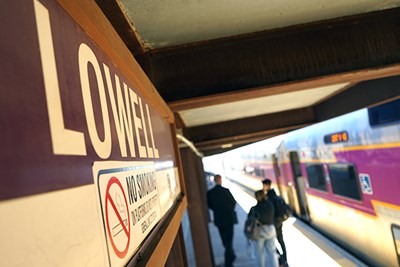With Addition of Larger Shuttle Buses, Transportation Services Develops CDL Training for Student Drivers
 Image by Ed Brennen
Image by Ed Brennen
11/27/2018
By Ed Brennen
How does parallel parking a 45-foot-long yellow school bus help a business student learn about analytics and operations management? Or help prepare a sound recording technology major for a career in the music industry?
In more ways than you might think.
Each year, the Office of Transportation Services hires and trains student employees to drive River Hawk Roadster shuttle buses on campus. Until recently, the university’s fleet consisted of a dozen 14-passenger shuttles, which can be operated with a standard (Class D) driver’s license. (UML also contracts with an outside company, North Reading Transportation, to operate full-length buses.)
But with more students relying on shuttles to get around campus, particularly on weekend nights, the university has begun to roll out new 25- and 30-passenger shuttles – slightly larger buses that require operators to have a commercial driver’s license (CDL).
And that’s where parallel parking a school bus comes in.
Transportation Services, under the guidance of Director of Administrative Services Nick Piscitello and Manager of Parking & Transportation Karina Cruz, developed its own student-led, in-house training program to help student drivers earn their CDL licenses.
“I came to college as a quiet art kid. I never thought I’d be in some sort of supervisor position.” -Team Coordinator Caitlin Mitchell ’18
Besides improving service to riders and increasing efficiencies to save the university money, the program has created leadership and management opportunities for students charged with running the training.
“I came to college as a quiet art kid. I never thought I’d be in some sort of supervisor position,” says Caitlin Mitchell, who began working as a shuttle driver and dispatcher as a sophomore. The Lunenburg native graduated in May with a bachelor of fine arts degree (and a minor in art history) but has stayed on with Transportation Services, working part-time as a team coordinator.
“Working here turned out to be one of the best choices I made in college,” says Mitchell, who developed the CDL training program last spring along with three current students: senior civil engineering major Justin Wadsworth, senior SRT major Jake Swain and junior business administration major Nathan Klosowski.
After completing 60 hours of training in full-length school buses with North Reading Transportation (NRT) and earning their CDL licenses in 2017, the quartet was asked (or “voluntold,” as Piscitello puts it) to develop UML’s own training program. In short order, they produced a binder-sized training manual and a two-hour PowerPoint presentation to guide students through a five-week program.
“They really took the training program from NRT to the next level,” says Piscitello, who also provided the team with some best practices and procedures from UMass Amherst, which runs a similar student-to-student CDL training program on its campus.
Last summer, UML ran its first two training sessions, which helped 15 more students pass the state CDL exam. As part of the program, Transportation Services covers each student’s licensing and exam fees. In addition to a written test, the exam includes driving a shuttle through an obstacle course and an on-road test.
“It’s a little intimidating – you don’t know where the back of the bus is because it just keeps going – but it’s a lot of fun,” says Klosowski, a Lowell native who joined Transportation Services two years ago. With a concentration in analytics and operations management, he hopes to work in the transportation industry.
 Image by Ed Brennen
Image by Ed Brennen
“I’d like to focus on the operations and logistics of vehicles,” Klosowski says, “so this has been the perfect experience.”
Likewise for Wadsworth, who plans to go into transportation engineering.
“This fits right in with traffic flow and bus mapping. It’s given me a lot of hands-on experience,” says Wadsworth, who joined the office as a sophomore and has worked his way up to team coordinator.
Piscitello credits Cruz with building a strong team of student employees who can advance and grow on the job.
“We want to provide opportunities for students to gain skills beyond just driving,” says Piscitello, who has managed transportation since 2008. In that time, he’s seen the operation grow from four shuttles and 16 employees to 12 shuttles and 80 employees (including around 65 student drivers).
“The university has really invested in transportation,” says Piscitello, whose office replaced four of the old shuttles with 25-passenger models this fall and plans to add two 30-passenger shuttles in the spring. All of the new shuttles have ramps or lifts and meet Americans with Disabilities Act (ADA) standards for accessibility.
Piscitello estimates the new in-house CDL program, which will offer training sessions again next summer, will save the university “hundreds of thousands of dollars a year” by allowing it to scale back on some of its contracted services.
And with nearly half of the office’s annual budget going to payroll for students and part-time staff, Piscitello adds that “it’s a great opportunity to earn money and gain experience outside the classroom.”
That’s true for Swain, who admits that working in transportation was a little outside of his comfort zone as a music student.
“But it’s a really great place to work. The team here is different than any place I’ve worked before,” says Swain, a Peabody native who has also advanced to team coordinator. “I’ve learned so much about myself, and I’ve grown in ways that I wouldn’t have in any other job.”
And even if Swain and his fellow student trainers never have to parallel park another school bus in their lives, Cruz says they’ve benefited from the experience.
“They’ve developed the ability to train an employee, whatever the content is,” she says. “They’ve learned skills to adapt to different learning styles, which is really the critical piece.”




